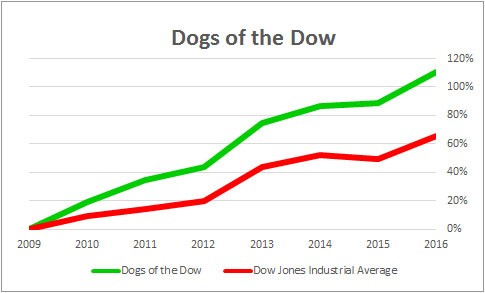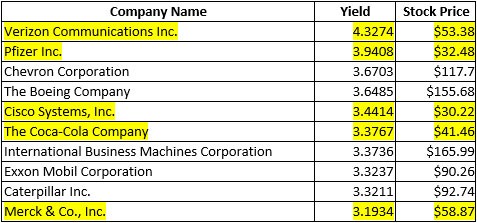It’s the start of 2017, and everybody is looking for that foolproof system to help them outperform the market in the new year.
While we all know there isn’t a foolproof system for investing, many analysts play to this idea by offering predictions and suggesting that one sector or another will outperform the rest.
As I mentioned last week, I don’t prefer to take that approach, but I realize that we all look for a simple and effective investment strategy for the new year.
Well, if you want to position your portfolio today for the full year, there’s one proven strategy that is easy and profitable that is worth focusing on: the Dogs of the Dow.
The Dogs of the Dow is a simple approach to investing that you implement at the beginning of each year.
You simply identify the stocks within the Dow Jones Industrial Average that have the highest yield right before the end of the year, then you buy those stocks at the start of the new year and hold them until the end.
By following this easy strategy, you would have outperformed the Dow Jones Industrial Average for the past seven years. Take a look:

You can see the Dogs of the Dow (in green) easily outpaced the Dow (in red) over the past seven years.
Many people believe this streak may be coming to its end with interest rates set to rise, but I’m willing to give the streak at least another year.
Let me explain…
Don’t Bet on a Yield Comeback
With expectations that the Federal Reserve will raise its benchmark interest rates several times this year, investors are cautious on high-yielding companies and other rate-sensitive stocks.
The expectation is that when interest rates rise, the appeal of buying dividend-paying stocks falls since you can easily go to your bank and take out a certificate of deposit — those offered a yield of 3% or more in the golden days. Or you can buy a U.S. Treasury note yielding 4% or 5%.
But the truth is those days won’t be coming back in 2017 and likely won’t return until at least the 2020s, given the sensitive nature of the interest-rate topic.
For instance, rising interest rates have the power to curb business investments and increase payments on government debt, thus slowing our economy and crippling our government.
A gradual rise in rates would likely be welcomed by almost anyone at this point, but that puts us at about 1.25% on the Federal Reserve’s target rate toward the end of next year — assuming the Fed goes through with three quarter-point hikes this year … which I doubt it will.
After all, we were supposed to see three rate hikes in 2016 according to the Fed at the end of 2015, and we all know how that turned out.
Even if the Fed manages to push through three rate hikes this year, a 1.25% rate is a far cry from the 5% rates that supported high-yield Treasury and bank notes prior to 2008.
In other words, don’t expect these traditional yield sources to come back anytime soon — you are going to have to rely on unique sources of income.
The Dogs of the Dow may be one of your answers, but there’s also a variation on this strategy that’s even more promising.
Let’s Get Small
Sure, the Dogs of the Dow strategy has outperformed the Dow in seven of the past 10 years. But, by making a slight tweak to the strategy, you could have averaged an annual gain of more than 20% since 1973. What’s more, this modification to the strategy is up 10.1% since 2000, compared to a 7.9% gain for the regular Dogs of the Dow and a 6.3% gain for the Dow during the same time frame.
It’s known as the Small Dogs of the Dow.
Instead of buying the 10 largest dividend-yielding stocks, you take that same list but buy only those five stocks that have the lowest stock price. For example, you wouldn’t buy IBM stock since it’s priced at more than $130 per share, but you would buy Cisco Systems for under $30.
Here’s a chart of the Dogs of the Dow, with the Small Dogs of the Dow highlighted in yellow.

To outperform the Dow this year, this is your easiest bet … assuming the seven-year win streak holds true.
Regards,

Chad Shoop
Editor, Automatic Profits Alert



